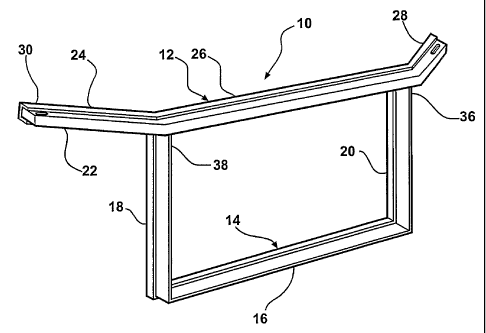Some of the information on this Web page has been provided by external sources. The Government of Canada is not responsible for the accuracy, reliability or currency of the information supplied by external sources. Users wishing to rely upon this information should consult directly with the source of the information. Content provided by external sources is not subject to official languages, privacy and accessibility requirements.
Any discrepancies in the text and image of the Claims and Abstract are due to differing posting times. Text of the Claims and Abstract are posted:
| (12) Patent: | (11) CA 2454343 |
|---|---|
| (54) English Title: | COMPOSITE COMPONENT INTEGRATION PANEL |
| (54) French Title: | PANNEAU D'INTEGRATION DE COMPOSANTS COMPOSITES |
| Status: | Expired |
| (51) International Patent Classification (IPC): |
|
|---|---|
| (72) Inventors : |
|
| (73) Owners : |
|
| (71) Applicants : |
|
| (74) Agent: | BRANDT, KERSTIN B. |
| (74) Associate agent: | |
| (45) Issued: | 2010-10-12 |
| (86) PCT Filing Date: | 2002-07-18 |
| (87) Open to Public Inspection: | 2003-01-30 |
| Examination requested: | 2007-07-12 |
| Availability of licence: | N/A |
| (25) Language of filing: | English |
| Patent Cooperation Treaty (PCT): | Yes |
|---|---|
| (86) PCT Filing Number: | PCT/CA2002/001095 |
| (87) International Publication Number: | WO2003/008256 |
| (85) National Entry: | 2004-01-19 |
| (30) Application Priority Data: | |||||||||
|---|---|---|---|---|---|---|---|---|---|
|
A panel assembly (10) is securable to a front end of a motor vehicle for
positioning and securing a plurality of elements thereto. The panel assembly
has a core (22) connectable to the front end of a motor vehicle. A skin (24)
covers the core (22). A component mounting structure is molded to the skin
(24). The component mounting structure is adapted to have the plurality of
elements attached thereto in spaced relation. The panel assembly (10) may be
assembled to the motor vehicle with the plurality of elements secured thereto.
L'invention concerne un ensemble panneau (10) pouvant être fixé à l'extrémité avant d'un véhicule à moteur afin de placer et de fixer une pluralité d'éléments. Ce panneau comporte une âme (22) reliée à l'extrémité avant d'un véhicule à moteur. Une enveloppe (24) recouvre l'âme. Une surface de fixation de composants est moulée dans l'enveloppe. La structure de fixation de composants est conçue de manière à recevoir la pluralité des éléments fixés à cette dernière de manière espacée. L'ensemble panneau (10) peut être assemblé dans le véhicule à moteur avec la pluralité des éléments fixés audit ensemble panneau.
Note: Claims are shown in the official language in which they were submitted.
Note: Descriptions are shown in the official language in which they were submitted.

For a clearer understanding of the status of the application/patent presented on this page, the site Disclaimer , as well as the definitions for Patent , Administrative Status , Maintenance Fee and Payment History should be consulted.
| Title | Date |
|---|---|
| Forecasted Issue Date | 2010-10-12 |
| (86) PCT Filing Date | 2002-07-18 |
| (87) PCT Publication Date | 2003-01-30 |
| (85) National Entry | 2004-01-19 |
| Examination Requested | 2007-07-12 |
| (45) Issued | 2010-10-12 |
| Expired | 2022-07-18 |
There is no abandonment history.
| Fee Type | Anniversary Year | Due Date | Amount Paid | Paid Date |
|---|---|---|---|---|
| Application Fee | $400.00 | 2004-01-19 | ||
| Registration of a document - section 124 | $100.00 | 2004-06-21 | ||
| Maintenance Fee - Application - New Act | 2 | 2004-07-19 | $100.00 | 2004-06-21 |
| Maintenance Fee - Application - New Act | 3 | 2005-07-18 | $100.00 | 2005-06-14 |
| Maintenance Fee - Application - New Act | 4 | 2006-07-18 | $100.00 | 2006-06-20 |
| Maintenance Fee - Application - New Act | 5 | 2007-07-18 | $200.00 | 2007-06-15 |
| Request for Examination | $800.00 | 2007-07-12 | ||
| Maintenance Fee - Application - New Act | 6 | 2008-07-18 | $200.00 | 2008-06-18 |
| Maintenance Fee - Application - New Act | 7 | 2009-07-20 | $200.00 | 2009-06-12 |
| Maintenance Fee - Application - New Act | 8 | 2010-07-19 | $200.00 | 2010-06-15 |
| Final Fee | $300.00 | 2010-07-29 | ||
| Maintenance Fee - Patent - New Act | 9 | 2011-07-18 | $200.00 | 2011-06-14 |
| Maintenance Fee - Patent - New Act | 10 | 2012-07-18 | $250.00 | 2012-06-26 |
| Maintenance Fee - Patent - New Act | 11 | 2013-07-18 | $250.00 | 2013-06-12 |
| Maintenance Fee - Patent - New Act | 12 | 2014-07-18 | $250.00 | 2014-06-25 |
| Maintenance Fee - Patent - New Act | 13 | 2015-07-20 | $250.00 | 2015-06-24 |
| Maintenance Fee - Patent - New Act | 14 | 2016-07-18 | $250.00 | 2016-06-22 |
| Maintenance Fee - Patent - New Act | 15 | 2017-07-18 | $450.00 | 2017-06-21 |
| Maintenance Fee - Patent - New Act | 16 | 2018-07-18 | $450.00 | 2018-06-27 |
| Maintenance Fee - Patent - New Act | 17 | 2019-07-18 | $450.00 | 2019-06-26 |
| Maintenance Fee - Patent - New Act | 18 | 2020-07-20 | $450.00 | 2020-06-24 |
| Maintenance Fee - Patent - New Act | 19 | 2021-07-19 | $459.00 | 2021-06-24 |
Note: Records showing the ownership history in alphabetical order.
| Current Owners on Record |
|---|
| DECOMA INTERNATIONAL INC. |
| Past Owners on Record |
|---|
| CHUBA, CHARLES JOHN |
| HENDERSON, JACK V. |
| HOUTARI, KEIJO J. |
| SCHULTZ, JOHN |